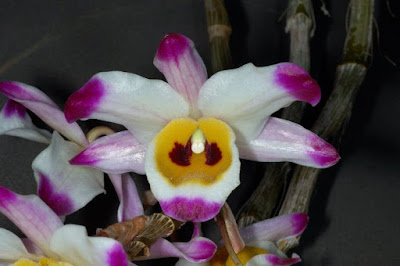Dendrobium wardianum is widely distributed in Southeast Asia. In India, they grow near Gangtok in Sikkim, in Bhutan, on Khasi (Khasia) Hills in Assam and in the Manipur region...
Dendrobium wardianum also called as Ward's Dendrobium, Callista wardiana, Dendrobium album, Dendrobium falconeri var wardianum, Dendrobium wardianum candidum, Dendrobium wardianum var. assamicum, Dendrobium wardianum var. pictum, is a species of the genus Dendrobium. This species was described by Robert Warner in 1862.
IDENTIFY DENDROBIUM WARDIANUM
Dendrobium wardianum is widely distributed in Southeast Asia. In India, they grow near Gangtok in Sikkim, in Bhutan, on Khasi (Khasia) Hills in Assam and in the Manipur region. The habitat extends further east through Myanmar, the mountains of northwest Thailand to the province of Yunnan in southwestern China. They usually grow on trees in mixed or deciduous forests, at heights of 1000-2000 m, but in China they were found growing on rocks and cliffs.
It is a medium to large sized, cool growing, epiphytic or lithophytic species, which reaching a height of 30-120 cm, with erect to pendulous, terete, nodally thickened, to 60 cm long stems carrying deciduous, oblong-lanceolate, acute, 8-15 cm long leaves.
Ward's Dendrobium blooms in the winter with 1 to 3 fragrant, long-lasting flowers on very short racemes that arise all along last years leafless canes. The flowers are 8-10 cm in diameter. The wide flakes of both whorls are thick and have blunt tops. They are white with a variable amount of purplish-pink color at the apexes. The white lip has a deep orange to lemon-yellow spot, purple lines, 2 purple spots at the base, and purple-pink at the apex. At the base, it rolls inside.
DENDROBIUM WARDIANUM CARE AND CULTURE
Cultural information should only be used as a guide, and should be to be adapted to suit you. Your physical location; where you grow your plants, how much time you have to devote to their care, and many other factors, will need to be taken into account. Only then can you decide on the cultural methods that best suit you and your plants.
Light:
Dendrobium wardianum needs a light level of 25000-35000 lux. Shading is required from spring to autumn, but the light level should be as high as possible, which the plant can tolerate without scalding the leaves.
Temperature:
The average temperature of the summer day is 23-25 ° C, the night 16-17 ° C, giving a daily difference of 7-9 ° C. In spring, the average day temperature is 27-28 ° C, night 10-16 ° C, giving a daily difference of 11-18 ° C. In winter, the average day temperature is 22-25 ° C, the night 6-7 ° C, giving a daily difference of 15-18 ° C.
Humidity:
Ward's Dendrobium need the humidity of 75-85% from late spring to autumn, but it drops to almost 60% at the end of winter and early spring.
Substrate, growing media and repotting:
Dendrobium wardianum can be grown mounted on tree ferns or cork, but the stems should be fixed so that they grow vertically. You can put the plants in baskets and allow them to hang freely. The baskets should be filled with any loose, quickly drying substrate.
Watering:
From the end of spring to the beginning of autumn, the precipitation is moderate to heavy, but it is very dry in winter. The cultivated plants should be moist during active growth, but when the new growth reaches maturity in autumn, the amount of water should be reduced.
Fertilizer:
Weekly use 1/4-1/2 doses of fertilizers for orchids are recommended. From spring to mid-summer, high-nitrogen fertilizer is recommended, and then until the end of autumn high-phosphoric fertilizer.
Rest period:
Cold, dry rest period is very important for Dendrobium wardianum and should last until new growths appear in the spring. This species can tolerate the winter temperature below 0 ° C with minimal damage if the plant is dry, but such extreme conditions should be avoided in cultivation.
You can eliminate water in winter, but the plants are in better condition if during the winter they allow them to dry out between waterings, but they can not stay dry for too long. Within 1-2 months at the end of winter, the plants should dry completely between waterings and remain dry for a slightly longer period. Occasional morning fogging between waterings should prevent too much drying. Fertilization should be significantly reduced or eliminated until spring, when normal watering begins.















COMMENTS